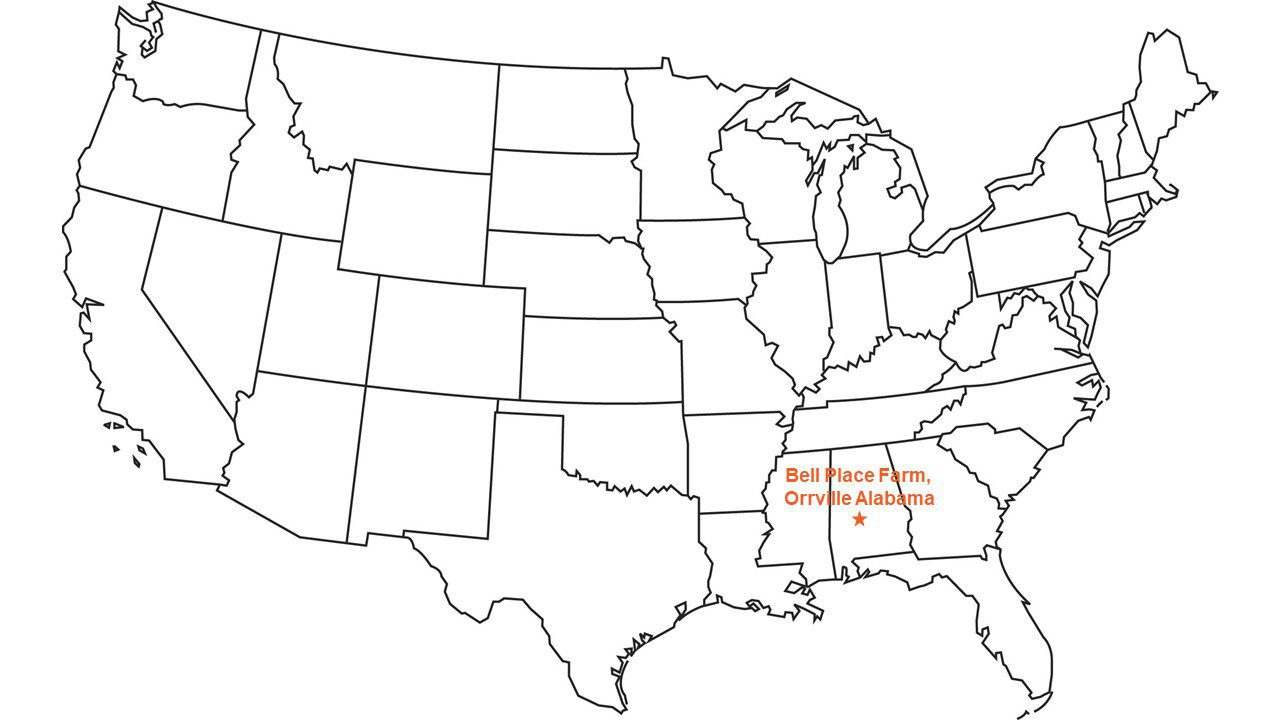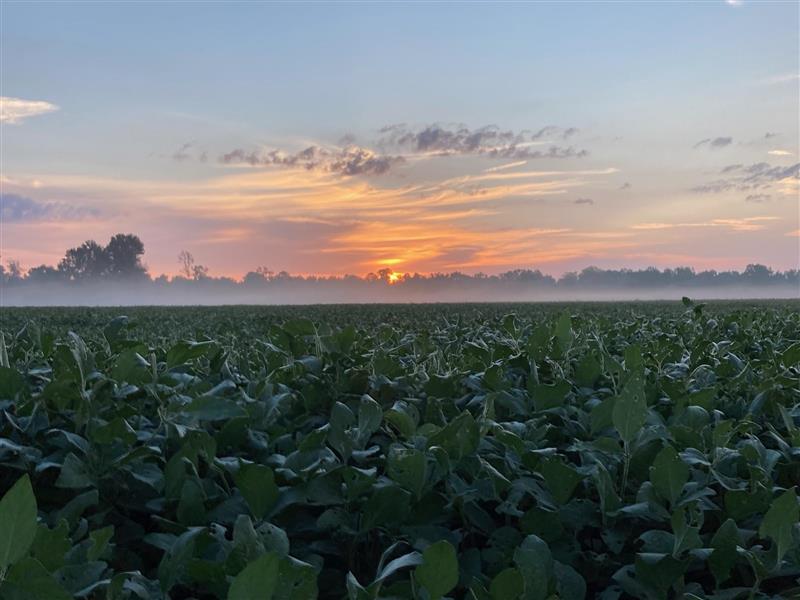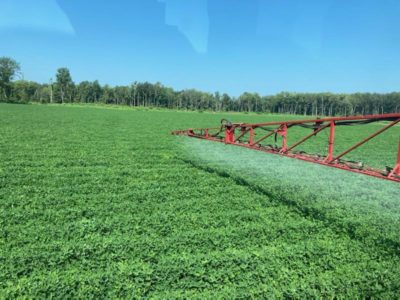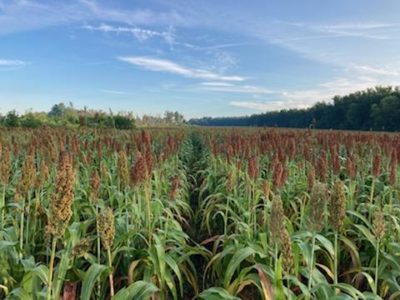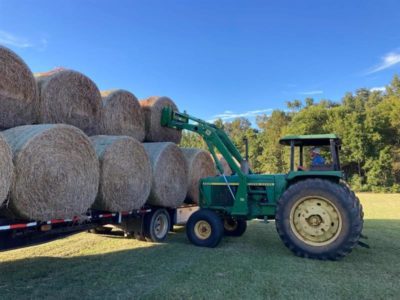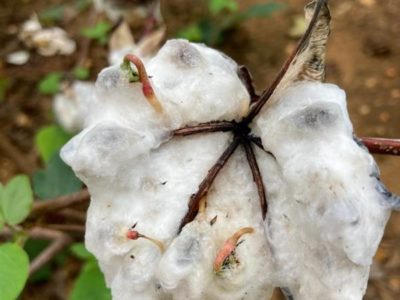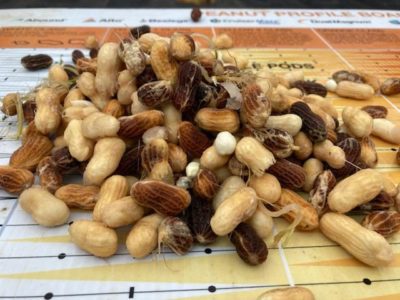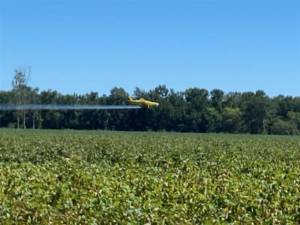 Our crops are maturing, and that means fall fieldwork is just getting started. With our crop rotation, that means we are managing crops in a variety of late stages of maturity. An abundance of rain in mid-September slowed some fieldwork, but the crops keep marching toward the finish line, helping us get closer to harvest.
Our crops are maturing, and that means fall fieldwork is just getting started. With our crop rotation, that means we are managing crops in a variety of late stages of maturity. An abundance of rain in mid-September slowed some fieldwork, but the crops keep marching toward the finish line, helping us get closer to harvest.
The single-crop soybeans are filling pods consistently throughout the field, and they look really good. They are nearing full maturity, but it will still be at least a month or more before they are ready for harvest. They are adding yield while we care for other crops, and the soybeans will wait for their turn with the combine.
We added a fungicide application to protect our double-crop soybeans from diseases, and it was delayed about a week because of rain. That means the pods have formed and are developing. It’s good practice in a tropical environment, like we’ve been experiencing this summer in our area of the southern U.S., to add some disease protection. We hired the airplane for this application because the fields were too wet for us to spray ourselves with our ground rig.
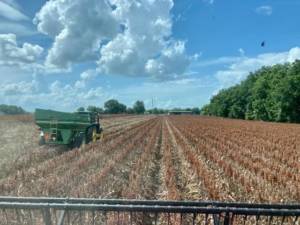 We harvested the single-crop sorghum in early September. Yields were above average. Early estimates show the sorghum yielded about 6 metric tons/hectare, or 94 bushels/acre This crop is stored in one of our grain bins, and it will be shipped to a poultry feed mill as soon as shipping is available. Transportation has been a challenge, as there is a shortage of truckers available to move grain to customers right now. The available truck drivers are hauling corn for farmers in the area harvesting that crop and shipping it from their fields.
We harvested the single-crop sorghum in early September. Yields were above average. Early estimates show the sorghum yielded about 6 metric tons/hectare, or 94 bushels/acre This crop is stored in one of our grain bins, and it will be shipped to a poultry feed mill as soon as shipping is available. Transportation has been a challenge, as there is a shortage of truckers available to move grain to customers right now. The available truck drivers are hauling corn for farmers in the area harvesting that crop and shipping it from their fields.
The heads of our double-crop sorghum are developing, and this crop is looking promising, as well. Like the double-crop soybeans, this will be one of the later crops we harvest. We have been in the bloom stage, and we have now entered the dough stage, when the grain is filling. I suspect we will harvest the double-crop sorghum in mid-October, depending on the weather.
We continue to apply fungicide to our peanuts every two weeks to keep the crop healthy. We have been taking samples of the peanuts to see how far they have matured. We expect that they will be ready to dig, or start turning the peanuts up out of the soil, by the end of September and through the first few days of October, which is about 10 days behind our average.
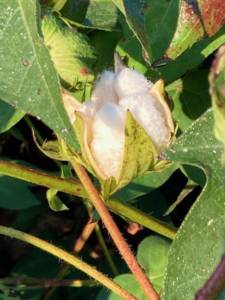 The cotton bolls are maturing quickly and starting to open up and fluff out. I think they are really pretty at this stage. We expect some of the the cotton to be ready to defoliate at the beginning of October, which means we apply a plant hormone that causes cotton plants to shut down, drop their leaves, further mature the bolls and open them up. The crop will be ready to pick 10 to 14 days after defoliation, depending on the weather. We contract out the picking of our cotton, so the crew will come to our fields to harvest them when we call and tell them the cotton is ready. We will likely be busy with other crops, including peanuts and sorghum, at that time.
The cotton bolls are maturing quickly and starting to open up and fluff out. I think they are really pretty at this stage. We expect some of the the cotton to be ready to defoliate at the beginning of October, which means we apply a plant hormone that causes cotton plants to shut down, drop their leaves, further mature the bolls and open them up. The crop will be ready to pick 10 to 14 days after defoliation, depending on the weather. We contract out the picking of our cotton, so the crew will come to our fields to harvest them when we call and tell them the cotton is ready. We will likely be busy with other crops, including peanuts and sorghum, at that time.
We’ve had plenty of rainy days in a two-week time period, which caused concern for our opening cotton crop. Early surveys after the sun dried out the fields revealed that our most mature fields showed some sprouts, hard lock and boll rot, which is not good. We will be docked for these quality issues at the gin. Hopefully these are isolated instances, and the sun and dry air will continue, so that we experience just minimal damage due to these issues.
We finished shipping wheat the third week of September, which freed up storage space for the crops we will soon be harvesting. I’ve also been trying to haul straw to our buyer. It’s always good to finish selling and shipping one crop, get cash flow coming in, and prepare to store another crop.
 Before our hectic fall schedule started, I had the opportunity to participate in a Soy Nutrition Institute meeting in Denver, Colorado. I had the privilege of sitting at the table with major food companies that buy soy protein to include in their products. I was able to share information about soybean production in the field and answer questions about farming practices. I also learned about the latest in soy protein research, which I found very interesting.
Before our hectic fall schedule started, I had the opportunity to participate in a Soy Nutrition Institute meeting in Denver, Colorado. I had the privilege of sitting at the table with major food companies that buy soy protein to include in their products. I was able to share information about soybean production in the field and answer questions about farming practices. I also learned about the latest in soy protein research, which I found very interesting.
When I have not able to be in the field, the days quickly get filled with a variety of work. I manage the marketing and logistics of selling our crops, like getting the wheat and single-crop sorghum shipped to customers, securing more contracts on our new crop and looking for more markets to sell. I also have a variety of commitments as a local school board member, vice-president of the state corn and soybean growers’ association and a United Soybean Board director. Our daughters are involved in a variety of school and extra-curricular activities, like dance, music and church activities. And events like my husband’s birthday and my birthday provide a chance to indulge in my baking hobby.
 Fall is without a doubt my favorite time of year! Soybean leaves start turning, the cotton opens up and sorghum heads turn beautiful dark bronze color. These colors, along with the smell of freshly dug peanuts, make my heart skip a beat. I love harvest. It is exciting and fulfilling to collect the fruits of our past year of labor. I expect to spend quite a bit of time in the combine during the next couple of months! With long days ahead of me and other farmers, I pray for sharp minds, steady hands, quick reflexes and an everlasting endurance for all of us to cross the harvest finish line. Happy harvest!
Fall is without a doubt my favorite time of year! Soybean leaves start turning, the cotton opens up and sorghum heads turn beautiful dark bronze color. These colors, along with the smell of freshly dug peanuts, make my heart skip a beat. I love harvest. It is exciting and fulfilling to collect the fruits of our past year of labor. I expect to spend quite a bit of time in the combine during the next couple of months! With long days ahead of me and other farmers, I pray for sharp minds, steady hands, quick reflexes and an everlasting endurance for all of us to cross the harvest finish line. Happy harvest!
This field update is funded by the soybean checkoff. To share or republish part or all of this Ground Work 2021 article, please link to the original article and credit www.USSOY.org.
